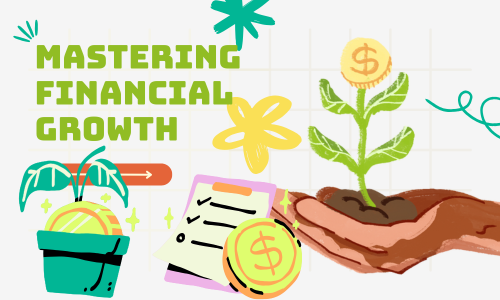This site may contain links to affiliate websites, and I may earn a commission for any purchases made through those links at no additional cost to you.

Mastering Financial Growth: Essential Tools for Budgeting, Investing, and Saving
1. Introduction to Financial Growth
- Define Financial Growth: Explain what financial growth means (building wealth, improving financial health, achieving long-term financial stability).
- Why It Matters: Discuss the importance of focusing on financial growth for a secure future.
- Preview of Tools: Briefly introduce the three main areas you’ll cover—budgeting, investing, and saving—as essential components for financial growth.
2. Budgeting: Laying the Foundation for Financial Growth
- What Is Budgeting? Define budgeting and its importance in personal finance.
- How Budgeting Affects Financial Growth: Discuss how budgeting helps you control spending, track income, and avoid debt.
- Tools for Budgeting:
- Mint: Tracks spending and sets budget goals.
- YNAB (You Need a Budget): Helps you plan for each dollar and prioritize savings.
- PocketGuard: Simplifies budgeting by showing how much disposable income you have after bills.
- Tips for Successful Budgeting:
- Set clear monthly limits for categories (e.g., food, entertainment).
- Use apps to automate savings.
- Track expenses regularly.
3. Investing: Growing Your Wealth Over Time
- Why Investing Matters: Explain how investing accelerates financial growth through compound interest and long-term returns.
- Different Types of Investments:
- Stocks, Bonds, Mutual Funds: Basics of these investments and their risk/reward profiles.
- ETFs & Index Funds: Diversified, low-cost investment options for growth.
- Tools for Investing:
- Betterment: A robo-advisor that automatically manages and grows investments.
- M1 Finance: Lets you automate investing with personalized portfolios.
- Acorns: Invests spare change automatically.
- Tips for Successful Investing:
- Start early to take advantage of compound growth.
- Diversify your portfolio across different asset classes.
- Regularly review and rebalance your investments.
4. Saving: Building a Safety Net for Future Financial Growth
- Why Saving Is Key to Financial Growth: Discuss the importance of having an emergency fund and saving for specific goals (e.g., home, retirement).
- Different Saving Goals:
- Emergency Fund: Set aside 3–6 months’ worth of living expenses.
- Retirement: Contribute to retirement accounts like 401(k) or IRAs.
- Short-Term Goals: Save for vacations, major purchases, etc.
- Tools for Saving:
- Digit: Automatically transfers small amounts from your checking to savings based on spending habits.
- Qapital: Helps users set saving goals and automates transfers.
- Chime: Round up purchases to the nearest dollar and deposit the difference into savings.
- Tips for Successful Saving:
- Automate savings to make it effortless.
- Prioritize saving 20% or more of your income.
- Use high-yield savings accounts to grow your savings faster.
5. Sustainable Finance: Investing in Your Future and the Planet
- Sustainable Investing Explained: Introduce the concept of sustainable finance (investing in socially responsible and eco-friendly companies).
- How Sustainable Finance Supports Growth: Discuss how investing in companies with sustainable practices can align with both personal growth and environmental impact.
- Tools for Sustainable Finance:
- Aspiration Bank: Provides eco-friendly banking with no fossil fuel investments.
- Green Century Funds: Invest in environmentally responsible companies.
- Ethical Investment Platforms: Mention platforms like OpenInvest and EarthFolio for socially responsible investments.
- Tips for Sustainable Finance:
- Choose investments that align with your values.
- Focus on companies with strong ESG (Environmental, Social, and Governance) scores.
- Opt for green funds or eco-friendly investment portfolios.
6. Final Thoughts: Your Path to Financial Growth
- Review of the Three Pillars: Recap the importance of budgeting, investing, and saving for long-term financial growth.
- Take Action: Encourage readers to start with one area (e.g., budgeting) and gradually work toward investing and saving.
- Stay Consistent: Emphasize the importance of regular check-ins and goal adjustments for sustained growth.
- Share Your Success: Encourage readers to share their financial growth journeys and celebrate milestones!




